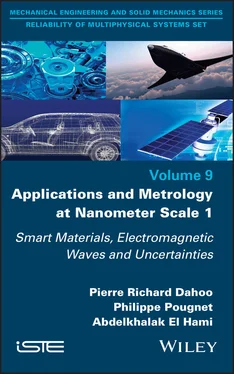ISTE Ltd
27-37 St George’s Road
London SW19 4EU
UK
www.iste.co.uk
John Wiley & Sons, Inc.
111 River Street
Hoboken, NJ 07030
USA
www.wiley.com
© ISTE Ltd 2021
The rights of Pierre-Richard Dahoo, Philippe Pougnet and Abdelkhalak El Hami to be identified as the authors of this work have been asserted by them in accordance with the Copyright, Designs and Patents Act 1988.
Library of Congress Control Number: 2020946679
British Library Cataloguing-in-Publication Data
A CIP record for this book is available from the British Library
ISBN 978-1-78630-640-1
The various actions taken worldwide in support of sustainable development and greenhouse gas emission control have led to increasingly restrictive regulations. Manufacturers in the automotive field have thus developed innovative mechatronic systems, enabling various vehicle functions to go electric. Confronted with the globalization of exchanges that has generated stronger competition and a surge of new product performances, companies in the sector of embedded mechatronic systems are developing new products at an increasingly faster rate.
In other domains, to achieve volume or mass reduction or curb energy dissipation, manufacturers of mechatronic systems are developing new assembly methods based on multimaterials (e.g. composite materials, hybrids) or on innovative nanomaterials (e.g. carbon nanotubes). Modeling is essential to reduce product development cost, shrink time to market, understand failure mechanisms occurring in the operating conditions and optimize design before launching production. The reliability-based design optimization (RBDO) method is a modeling approach that optimizes design, guarantees the required high level of performance and takes into account the variability in the manufacturing process as well as the climatic variability in the use conditions. The efficiency of RBDO, however, depends on a solid understanding of the failure mechanisms caused by aging.
Creating a model of a dynamic system often involves developing a simplified model of its behavior based on realistic hypotheses and on the key parameters that are required for its functioning. The dynamic behavior of this modeled system is ruled by partial differential equations (PDEs). The model is then improved by introducing elements or parameters that were not initially included and by improving the set of PDEs (nonlinearity, coupling, etc.), in order to obtain a model that closely represents the reality of operating systems and provides pertinent simulation results.
The theoretical models that are based on the fundamental laws of physics use a bottom-up approach. These models can be studied using analytical or numerical methods. When experiments can be implemented, simulation results are compared to experimental results. It is also possible to use experimental methods and a top-down approach to build a database of the response of the system to applied stresses. These data are then analyzed by comparing them to the response of theoretical or empirical models. In all the cases, there is a degree of uncertainty in the statistical analysis of the data, which leads to predictions with a margin of error. The lower the margin of error, the closer the predictions are to reality, leading to a sound understanding of the functionalities of working materials.
As Book 9 of the “Reliability of Multiphysical Systems Set”, this book is designed to provide applications for Book 2 in the set, entitled Nanometer-scale Defect Detection Using Polarized Light . This is achieved by describing the experimental and theoretical methods developed in fundamental research laboratories to understand the physics or chemical processes, which at the nanometer scale are at the origin of the remarkable properties of the materials introduced in innovative technological devices. It presents optical techniques based on polarized light, which are used to characterize interface and bulk material defects that have an impact on the performance of nanodevices. It also describes how mechanical properties of nanomaterials can be determined using theoretical models and by the analysis of experimental results and their uncertainties.
This book is intended for students at master and doctoral levels, teaching academics and researchers in materials science, physics engineering and experimental study, as well as R&D and manufacturing engineers of large groups and SMEs in the field of electronics, mechatronics, or optical or electronic materials.
Chapter 1 provides a historical overview of the development of nanosciences and nanotechnologies and describes the challenges encountered when working on the nanometric scale, such as finding new ways to measure the physical properties of nanomaterials. It provides an overview of the techniques used for manufacturing nanomaterials: spin coating, cathode sputtering and laser ablation. Four characterization and failure analysis techniques adapted to nanotechnologies are presented: transmission electron microscopy (TEM), scanning electron microscopy (SEM), atomic force microscopy (AFM) and attenuated total reflection (ATR) infrared spectroscopy.
Chapter 2 describes how to manage system variable uncertainties in the design process. The objective is to obtain a design that meets the performance requirements, has a stable response when design parameters vary randomly and respects a threshold of minimal performance for a given confidence level. Several methods for analyzing the effect on the output of uncertainties in the system input parameters are presented with practical applications: a probabilistic approach, interval analysis, a fuzzy logic method, designs of experiments and principal component analysis.
Chapter 3is dedicated to various applications of electromagnetic waves. After a quick summary of the main characteristics of electromagnetic waves and microwave antenna theory, the following applications are studied: energy of a monochromatic plane wave, properties of a rectangular waveguide, performance of a wire antenna and antenna networks. These applications facilitate the understanding of the operation of antennas for the fifth generation (5G) of mobile telecommunication systems.
Chapter 4 deals with functional materials employed in intelligent systems. The main characteristic of these intelligent materials is the coupling of their various physical properties. Thermodynamic coupling and multiphysics coupling are studied for piezoelectric, magnetostrictive and shape memory materials. Application exercises are provided for the deformations of a plate-like thin layer, a piezoelectric accelerometer, a piezoelectric transducer and a piezoelectric sensor.
Pierre Richard DAHOO
Philippe POUGNET
Abdelkhalak EL HAMI
October 2020
The scientific study of measurement is known as metrology. Any measure is based on a universally accepted standard and any measuring process is prone to uncertainty. In engineering science, measurement concerns various types of parameters. Legal metrology is imposed by a regulatory framework that the manufactured product must respect. Technical or scientific metrology involves the methods used to measure the technical characteristics of the manufactured product. In engineering sciences, measurement concerns various types of parameters. In a more general context of a systemic approach, metrology should also be considered in connection with other indicators of the production system. These measures enable the follow-up and development of the processes implemented for ensuring and optimizing product quality or reducing failure so that it meets client expectations. The ability of a product to meet quality and reliability expectations can be addressed in the design stage, according to a RBDO (Reliability-Based Design Optimization) approach described in the “Reliability of Multiphysical Systems Set Book 2”, entitled Nanometer-scale Defect Detection Using Polarized Light . More generally, RBDO makes it possible to consider the uncertain parameters of manufacturing processes, measurement and operational conditions in order to optimize the manufacturing process, the design parameters and the overall quality of the product.
Читать дальше












